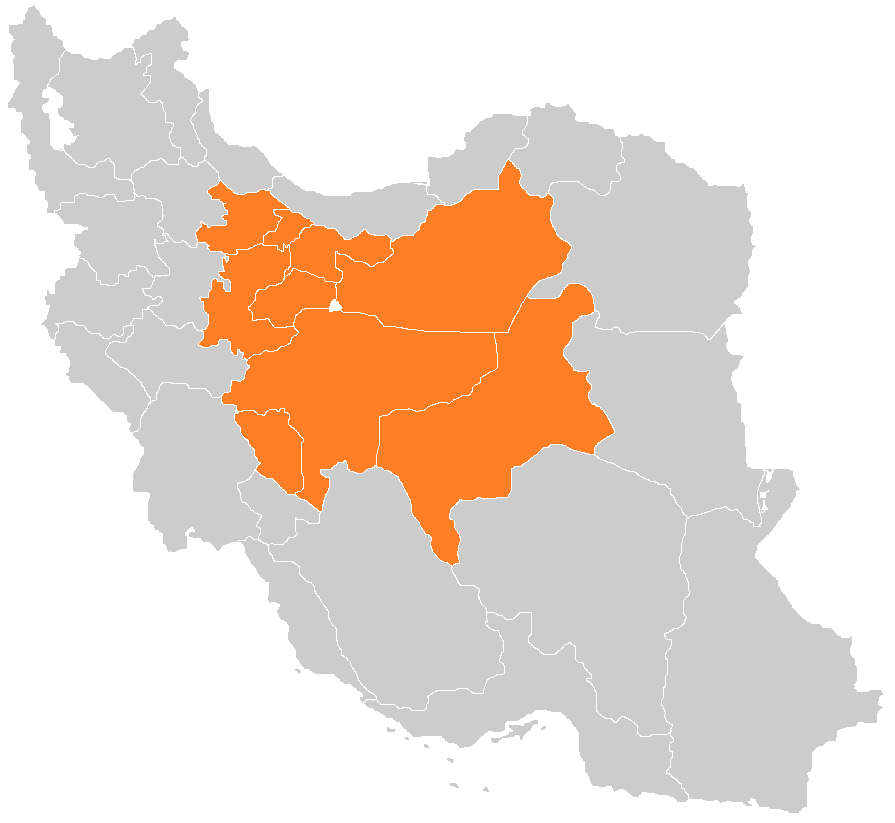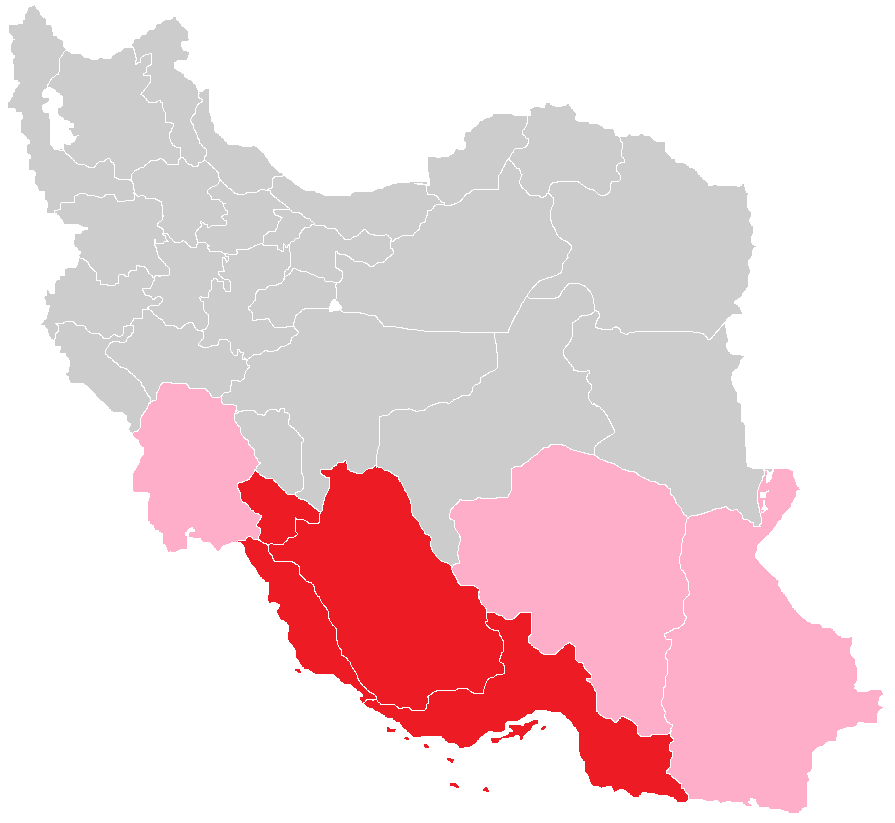|
Western Iran
Western Iran consists of Armenian Highlands, Northern Zagros and the rich agricultural area of the Khuzestan Plain in the south. It includes the provinces of Kordestan, Kermanshah, Ilam, Hamadan and Lorestan. Some references also count West Azerbaijan Province and Khuzestan Province to this region. The major cities are Sanandaj, Kermanshah, Ilam, Hamadan, Khorramabad sometimes Urmia and Ahvaz. Climate *Humid continental climate in the north. *Hot-summer Mediterranean climate in the north. *cold semi-arid climate in the Zagros mountains. * Warm summer continental climate all over the central mountain ranges. *Hot desert climate in Khuzestan. See also * Northern Iran * Southern Iran * Eastern Iran * Central Iran * Northwestern Iran Azerbaijan or Azarbaijan ( fa, آذربایجان, ''Āzarbāijān'' ; az-Arab, آذربایجان, ''Āzerbāyjān'' ), also known as Iranian Azerbaijan, is a historical region in northwestern Iran that borders Iraq, Turkey, the Nakhchi ... [...More Info...] [...Related Items...] OR: [Wikipedia] [Google] [Baidu] |
Ilam, Iran
Ilam ( fa, ; also romanized as Īlām) is a city and capital of Ilam Province, Iran. At the 2011 census, its population was 213,579 people, and 52,474 families. The Kabir Kuh mountain range lies east of the city. From the west it borders Iraq. Language The city is populated by Kurds who speak Southern Kurdish. Language composition: Architecture Like many other regions of Iran the architecture in Ilam includes traditional and contemporary periods. Although easy access to fossil fuels and electricity may have aided the transition in Iranian architecture in other regions of Iran from its traditional to modern styles, in Ilam the increasing population has also played a role. The Governor Castle, Falahaty Mansion and The Mirgholam Castle are examples of some surviving traditional buildings in Ilam. The courtyard dwelling is the main type of the buildings of this period. This type of building was accepted as the main building type over all Iran for both climatic and cultural rea ... [...More Info...] [...Related Items...] OR: [Wikipedia] [Google] [Baidu] |
Central Iran ...
Central Iran consists of the southern slopes of the Alborz Mountains in the north, the Zagros Mountains in south, the Central Iranian Range, and the desert of Dasht-e Kavir. It includes the provinces of Esfahan, Yazd, Chahar Mahal and Bakhtiari, Markazi, Qazvin, Alborz, Tehran, Qom and Semnan. The major cities are Tehran, Isfahan, Arak, Yazd, Karaj, Qazvin, Qom, Kashan, Saveh and Shahr-e Kord. Climate *Hot desert climate in the deserts. *Cold desert climate in the central mountains. *Humid continental climate on the few rivers. *cold semi-arid climate in the high mountains. See also * Northern Iran * Western Iran * Northwestern Iran * Eastern Iran * Southern Iran References {{Reflist Subdivisions of Iran Iran Iran, officially the Islamic Republic of Iran, and also called Persia, is a country located in Western Asia. It is bordered by Iraq and Turkey to the west, by Azerbaijan and Armenia to the northwest, by the Caspian Sea and Turkmeni ... [...More Info...] [...Related Items...] OR: [Wikipedia] [Google] [Baidu] |
Eastern Iran
Eastern Iran consists of the Lut Desert, the mountains ranges bordering Turkmenistan, Afghanistan and Pakistan, and the coastal strip of the Gulf of Oman. It includes the provinces of North Khorasan, Razavi Khorasan, South Khorasan and Sistan and Baluchestan sharing border with Turkmenistan, Afghanistan and Pakistan. Some references also count Kerman Province to this region. The major cities are Mashhad, Zahedan, Bojnurd, Birjand, Zabol, Chabahar and Neyshabur and sometimes Kerman. Climate *Hot desert climate in the plains and the south. *Cold desert climate in the north. *cold semi-arid climate in the mountain ranges. See also * Northern Iran * Western Iran * Southern Iran * Central Iran * Northwestern Iran Azerbaijan or Azarbaijan ( fa, آذربایجان, ''Āzarbāijān'' ; az-Arab, آذربایجان, ''Āzerbāyjān'' ), also known as Iranian Azerbaijan, is a historical region in northwestern Iran that borders Iraq, Turkey, the Nakhchiva ... References {{ ... [...More Info...] [...Related Items...] OR: [Wikipedia] [Google] [Baidu] |
Southern Iran
Southern Iran consists of the southern mountain ranges of Zagros and Central Iranian Range, Khuzestan Plain and the northern coasts of Persian Gulf and Straight of Hormuz. It includes the provinces of Fars, Kohgiluyeh and Buyer Ahmad, Hormozgan and Bushehr. Sometimes Khuzestan and Kerman are also included in this region. The major cities are Shiraz, Bandarabbas, Bushehr, Marvdasht, Jahrom, Yasuj, Fasa and Borazjan. Southern Iran is ethnically diverse, including Persians, Lurs, Bakhtiaris, Qashqais, Achomians, Basseries, Baloch, Arabs, Armenians, Afro-Iranians and Jews. Southern Iran is the homeland of the Persian people. Most people in southern Iran are ethnically Persian (including Persian subgroups like Lurs and Bakhtiaris). Most people in Southern Iran are part of the Iranian ethno-linguistic group and speak an Iranian language. Climate *Hot desert climate in the plains and the coast of the Persian Gulf. *Cold semi-arid climate A semi-arid climate, semi-de ... [...More Info...] [...Related Items...] OR: [Wikipedia] [Google] [Baidu] |
Northern Iran
Northern Iran consists of the southern border of the Caspian Sea and the Alborz mountains. It includes the provinces of Gilan, Mazandaran, and Golestan. (Ancient kingdom of Hyrcania, medieval region of Tabaristan). The major provinces, Gilan and Mazandaran, are covered with dense forests, snow-covered mountains and impressive sea shores. The major cities are Rasht, Gorgan, Sâri, Bâbol, Amol, Qaem Shahr, Gonbad-e Kavus, Anzali, and Lahijan. Northern Iran has numerous villages, particularly Massulé, appreciated by travellers. Northern Iran was a trendy spot during the Pahlavi era, especially among foreign tourists. It was a luxurious place that provided all types of modern recreational facilities as well as tourism infrastructure. Today, it's mostly visited by domestic tourists. Language Iran is a very diverse country. "Dialect wise" there are different sub-languages and dialects of native speakers in the north of Iran as well the rest of the country. From the eas ... [...More Info...] [...Related Items...] OR: [Wikipedia] [Google] [Baidu] |
Hot-summer Mediterranean Climate
A Mediterranean climate (also called a dry summer temperate climate ''Cs'') is a temperate climate sub-type, generally characterized by warm, dry summers and mild, fairly wet winters; these weather conditions are typically experienced in the majority of Mediterranean-climate regions and countries, but remain highly dependent on proximity to the ocean, altitude and geographical location. This climate type's name is in reference to the coastal regions of the Mediterranean Sea within the Mediterranean Basin, where this climate type is most prevalent. The "original" Mediterranean zone is a massive area, its western region beginning with the Iberian Peninsula in southwestern Europe and coastal regions of northern Morocco, extending eastwards across southern Europe, the Balkans, and coastal Northern Africa, before reaching a dead-end at the Levant region's coastline. Mediterranean climate zones are typically located along the western coasts of landmasses, between roughly 30 and 4 ... [...More Info...] [...Related Items...] OR: [Wikipedia] [Google] [Baidu] |
Humid Continental Climate
A humid continental climate is a climatic region defined by Russo-German climatologist Wladimir Köppen in 1900, typified by four distinct seasons and large seasonal temperature differences, with warm to hot (and often humid) summers and freezing cold (sometimes severely cold in the northern areas) winters. Precipitation is usually distributed throughout the year but often do have dry seasons. The definition of this climate regarding temperature is as follows: the mean temperature of the coldest month must be below or depending on the isotherm, and there must be at least four months whose mean temperatures are at or above . In addition, the location in question must not be semi-arid or arid. The cooler ''Dfb'', ''Dwb'', and ''Dsb'' subtypes are also known as hemiboreal climates. Humid continental climates are generally found between latitudes 30° N and 60° N, within the central and northeastern portions of North America, Europe, and Asia. They are rare and ... [...More Info...] [...Related Items...] OR: [Wikipedia] [Google] [Baidu] |
Ahvaz
Ahvaz ( fa, اهواز, Ahvâz ) is a city in the southwest of Iran and the capital of Khuzestan province. Ahvaz's population is about 1,300,000 and its built-up area with the nearby town of Sheybani is home to 1,136,989 inhabitants. It is home to Persians, Arabs, Bakhtiaris, Dezfulis, Shushtaris, and others. Languages spoken in the area include Persian and Arabic, as well as dialects of Luri ( Bakhtiari), Dezfuli, Shushtari, and others. One of the 2 navigable rivers of Iran alongside the Arvand Rud ( Shatt al-Arab), the Karun, passes through the middle of the city. Ahvaz has a long history, dating back to the Achaemenid period. In ancient times, the city was one of the main centers of the Academy of Gondishapur. Etymology The word Ahvaz is a Persianized form of the Arabic "Ahwaz," which, in turn, is derived from an older Persian word. The Dehkhoda Dictionary specifically defines the "Suq-al-Ahvaz" as "Market of the Khuzis", where "Suq" is the Elamite word for market, an ... [...More Info...] [...Related Items...] OR: [Wikipedia] [Google] [Baidu] |
Urmia
Urmia or Orumiyeh ( fa, ارومیه, Variously transliterated as ''Oroumieh'', ''Oroumiyeh'', ''Orūmīyeh'' and ''Urūmiyeh''.) is the largest city in West Azerbaijan Province of Iran and the capital of Urmia County. It is situated at an altitude of above sea level, and is located along the Shahar River on the Urmia Plain. Lake Urmia, one of the world's largest salt lakes, lies to the east of the city, and the mountainous Turkish border area lies to the west. Urmia is the 10th-most populous city in Iran. At the 2012 census, its population was 667,499, with 197,749 households. The majority of the city's residents are Azerbaijanis, with a large minority of Kurds, and a smaller number of Assyrians, and Armenians, as well as Persian-speakers who moved to the city mostly for employment. The city is the trading center for a fertile agricultural region where fruits (especially apples and grapes) and tobacco are grown. Even though the majority of the residents of Urmia are M ... [...More Info...] [...Related Items...] OR: [Wikipedia] [Google] [Baidu] |
Khorramabad
Khorramabad ( fa, خرمآباد, Khorramâbâd ), alternatively romanized as Khorramābād, Khoramabad, Khurramabad, Khorram Abad, or Khur Ramābād, is a city and the capital of Lorestan Province, Iran. At the time of the 2016 census, its population was 373,416 persons. Khorramabad is situated on the Zagros Mountains. Khorramabad Airport is 3 km south of the city proper. Khorramabad is the largest Luri-speaking city in Iran. The city population is predominantly Lur and Kurds. Although not a major tourist destination, it is quite scenic and possesses several attractions, such as five Paleolithic cave-dwelling sites. In the city center, a tall citadel called Falak-ol-Aflak (''The Heaven of Heavens''), a relic of the Sassanid era, is now a nationally popular museum. History Pre-Islamic era Simash During the late third millennium B.C. and early second millennium B.C., when Simashki sovereigns was ruling on Elam, for the first time a fort was built on the peak of a n ... [...More Info...] [...Related Items...] OR: [Wikipedia] [Google] [Baidu] |
Hamadan
Hamadan () or Hamedan ( fa, همدان, ''Hamedān'') (Old Persian: Haŋgmetana, Ecbatana) is the capital city of Hamadan Province of Iran. At the 2019 census, its population was 783,300 in 230,775 families. The majority of people living in Hamadan identify as ethnic Persians. Hamedan is believed to be among the oldest Iranian cities. It is possible that it was occupied by the Assyrians in 1100 BCE; the Ancient Greek historian, Herodotus, states that it was the capital of the Medes, around 700 BCE. Hamedan has a green mountainous area in the foothills of the 3,574-meter Alvand Mountain, in the midwest part of Iran. The city is 1,850 meters above sea level. The highly cultural nature of this old city and its historic sites attract tourists during the summer to this city, located approximately southwest of Tehran. The major sights of this city are the Ganj Nameh inscription, the Avicenna monument and the Baba Taher monument. The main language in the city is Persian. History ... [...More Info...] [...Related Items...] OR: [Wikipedia] [Google] [Baidu] |








